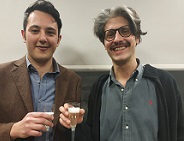Michele's thesis abstract:
"Tuning the Photoluminescence Emission Wavelength of Ge/SiGe Quantum Wells: Leveraging on Quantum Confinement, Strain, and Doping"
Despite its huge supremacy in the world of electronic circuits, the role of silicon in optoelectronic applications is still hindered by its poor radiative efficiency, and commercially available photonic devices consist mainly of III-V lasers that are good light emitters but are not fully integrable into the CMOS technology. Among the several approaches that have been proposed for the realization of an efficient, Si-compatible light emitter, Ge/SiGe multiple quantum wells (QWs) have attracted great interest since they meet the requirements of compatibility with the CMOS technology and light emission in the commercially important C-band (1530-1565 nm) of telecommunications. Moreover, when the carrier density in the direct conduction band of Ge is increased either by high tensile strain and/or heavy n-type doping, its radiative efficiency can be greatly enhanced and highly efficient sources can be envisaged. In this work, we investigate how the optical properties of Ge/SiGe heterostructures can be tuned leveraging on quantum confinement, strain, and doping. To satisfy the important requirement of compatibility with the standard Sibased microelectronics CMOS platform, the samples here investigated have been grown on Si(100) substrates by means of ultra-high vacuum chemical vapor deposition. To reduce the density of crystal defects, that are detrimental for the efficiency of optoelectronics devices, the high-x Si1−xGex heterostructures are deposited on SiGe reverse-graded virtual substrates, where the lattice mismatch is gradually distributed among several layers. After discussing the growth technique, the structural and optical properties of the virtual substrates will be thoroughly investigated to isolate the properties of the heterostructures from those of the substrate. Once that a detailed characterization of the properties of the virtual substrate has been carried out, we report the structural and optical properties of the symmetric multi-quantum wells. A detailed investigation of this simple structure allows to evaluate the modification of the optical properties induced by external stress, doping and coupling between adjacent quantum wells. The structural characterization have been performed in order to retrieve the properties of the samples needed for the calculation of their electronic states and to assess therefore the quality of the proposed model system. The good agreement between experimental data and theoretically predicted transition energies validates the proposed modeling and allows us to to unambiguously interpret the emission spectra. We demonstrate the enhanced direct-gap photoluminescence (PL) from Ge/SiGe quantum-wells compared to bulk Ge, indicating that this material is a promising candidate for making an efficient light source on a Si platform. Since the effect of quantum confinement is to blueshift the emission wavelength of Ge from the commercially important C-band (0.79-0.81 eV) to the E-band (at RT), there is a significant demand to redshift the emission back to a wavelength range suitable for potential applications. This can be achieved exploiting tensile strain. Tensile strain has been induced in the Ge quantum wells by means of an external SiN stressor. Microstructures of different size and shape have been fabricated, allowing the Ge layers to freely expand into one, or two dimensions, resulting in different strain distribution profiles along the structure. The strain relaxation of the microstructures was modeled using COMSOL Multiphysics, a 3D finite element tool, and a maximum strain of 0.3% was predicted for 3 µm-wide pillars. A redshift of ∼33 meV of the direct recombination was indeed observed in the PL spectra acquired on 3 µm-wide pillars. With the aim of boosting the PL signal of direct recombinations in the QWs, we deposited and investigated heavily n-doped Ge QWs. We found that the PL signal is not a monotonically increasing function of the donor concentration, but shows a maximum at a dopant concentration in the 1 − 4 × 1017 cm−3 range. Increasing further the amount of dopants the PL intensity of the direct transition is completely quenched due to the reduced crystal quality that results in an increase of SRH non-radiative recombinations. Finally, the possibilty of relaxing the selection rules for inter-band transitions in quantum wells, is demonstrated studying the optical properties of asymmetric quantum wells. In conclusion, the present work of thesis presents a comprehensive study on Ge/SiGe quantum wells that provides a useful step towards the understanding of the optical properties of group-IV quantum wells for opto-electronic applications and their exploitation in the realization of engineered structures featuring properties suitable for the future implementation in a silicon-based lasing structure for light emission in the C-band of telecommunications.
